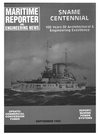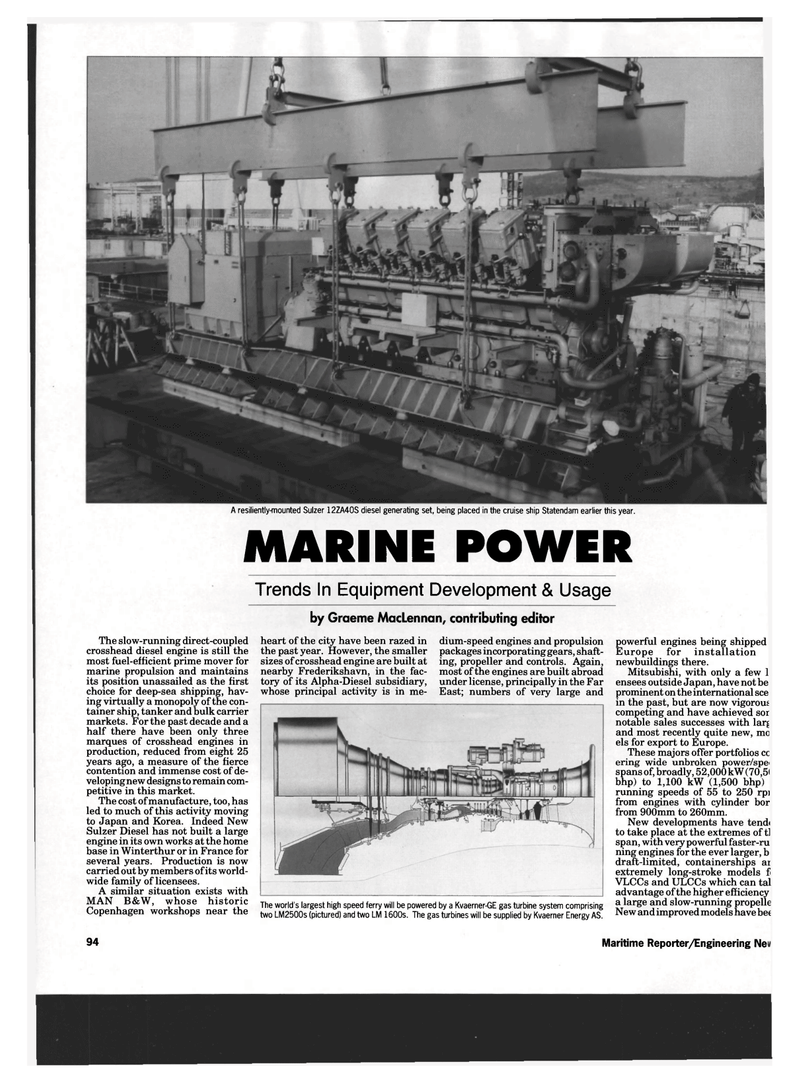
Page 100: of Maritime Reporter Magazine (September 1993)
Read this page in Pdf, Flash or Html5 edition of September 1993 Maritime Reporter Magazine
A resiliently-mounted Sulzer 12ZA40S diesel generating set, being placed in the cruise ship Statendam earlier this year.
MARINE POWER
Trends In Equipment Development & Usage by Graeme MacLennan, contributing editor
The slow-running direct-coupled crosshead diesel engine is still the most fuel-efficient prime mover for marine propulsion and maintains its position unassailed as the first choice for deep-sea shipping, hav- ing virtually a monopoly of the con- tainer ship, tanker and bulk carrier markets. For the past decade and a half there have been only three marques of crosshead engines in production, reduced from eight 25 years ago, a measure of the fierce contention and immense cost of de- veloping new designs to remain com- petitive in this market.
The cost of manufacture, too, has led to much of this activity moving to Japan and Korea. Indeed New
Sulzer Diesel has not built a large engine in its own works at the home base in Winterthur or in France for several years. Production is now carried out by members of its world- wide family of licensees.
A similar situation exists with
MAN B&W, whose historic
Copenhagen workshops near the heart of the city have been razed in the past year. However, the smaller sizes of crosshead engine are built at nearby Frederikshavn, in the fac- tory of its Alpha-Diesel subsidiary, whose principal activity is in me- dium-speed engines and propulsion packages incorporating gears, shaft- ing, propeller and controls. Again, most of the engines are built abroad under license, principally in the Far
East; numbers of very large and
The world's largest high speed ferry will be powered by a Kvaerner-GE gas turbine system comprising two LM2500s (pictured) and two LM 1600s. The gas turbines will be supplied by Kvaerner Energy AS. powerful engines being shipped
Europe for installation newbuildings there.
Mitsubishi, with only a few 1 ensees outside Japan, have not be prominent on the international see in the past, but are now vigorous competing and have achieved sor notable sales successes with larf and most recently quite new, mc els for export to Europe.
These majors offer portfolios cc ering wide unbroken power/spe< spans of, broadly, 52,000 kW (70,5i bhp) to 1,100 kW (1,500 bhp) running speeds of 55 to 250 rpi from engines with cylinder bor from 900mm to 260mm.
New developments have tendi to take place at the extremes of tl span, with very powerful faster-ru ning engines for the ever larger, b draft-limited, containerships ai extremely long-stroke models f
VLCCs and ULCCs which can tal advantage of the higher efficiency a large and slow-running propelle
New and improved models have be« 94 Maritime Reporter/Engineering News

 99
99

 101
101
